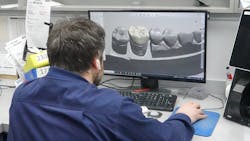There are many doctors who still believe 3D printers are an unnecessary hassle that require too much training, and they see them as work that doesn’t justify the reward. After some focused lessons on the printers themselves, and the return on investment (ROI) and technology surrounding them, I’m happy to report that this is not the case. Considering the wide array of items that you would typically pay a lab to create, such as aligners, surgical guides, models, night guards, and more, 3D printing presents an opportunity for profit in every specialty.
Let’s look under the hood, shall we? The first 3D printers were designed with stereolithography (SLA technology), which means that a laser moves around the platform, essentially telling the resin what to create. While this alone is amazing technology, as you add items to the print queue the laser takes more time to run around the platform. This obviously requires more time to complete the job with each added item. Eventually, digital light processing (DLP technology) was developed and adapted to many models, and it uses image projection instead of lasers. The DLP projects the design to the printer as a whole, which makes the process significantly more efficient. While there are probably some advantages to using SLA technology, the latter seems more likely to last as the industry standard.
3D printing involves four basic stages, and they do not all have to be done internally. First, there is digital scanning, which hopefully you’re doing by now. Or you can start by understanding what CAD/CAM dentistry in general will bring to the table by reading my article, “Is CAD/CAM a good fit for your practice?” Next is designing, the process of converting scans into printable work (possibly the least desirable task), and then the printing itself. The fourth stage is the preparatory work to get the items ready for the patient, but this is as easy as arts and crafts in elementary school. This is the post-process, and many manufacturers make it as seamless as putting clothes in the dryer.
The time is right!
According to Matthew Thompson, head of growth marketing at SprintRay Inc., the last 18 months has seen a boom in business due to the desire to create an end-to-end business with as little outsourcing as possible. Also, the price has finally hit the right spot. “3D printing technology and pricing have reached an inflection point where the return on investment and patient benefit are undeniable,” Thompson said. “Meanwhile, innovations in the materials space continue adding to a growing suite of indications. Today, in-office dental 3D printing simply makes perfect sense.”
Are you concerned about pricing? Consider this: you can save up to 75% of your lab bill by taking some of the easy work off the lab’s hands and using them just for the design work. As with anything,a once you do it a few times you’ll wonder why you sent these out for so long. Some dentists are spending thousands of dollars each month having other people do what is now easy work on relatively inexpensive equipment (considering the savings potential). If you research specific brands, you can find deals that bundle the resins in with the printer, along with other combinations of accessories to speed up the post-process, making it a breeze compared to days past. There are also bundles that package intraoral scanners to complete the digital workflow. A good sales rep will tell you everything you need to know to get the right package for your office.
If you are averse to relying on your own design skills, don’t fret; creating print files from the scans does not have to be your responsibility. While you’ll surely become a design master with a bit of practice, no one would blame you for entrusting that work to your loyal lab team. Let them handle the design work and you can easily upload items to the printer. 3D printing does not mean you’ll be stuck at the control panel all day; those days are long gone. Besides, your team will be happy to master all the new tech toys.
What’s the bottom line? If you’re in the business of orthodontics, oral surgery, or sleep dentistry, this is a no-brainer. The price is now in line with the return on investment, and even if you send out the scans to eliminate the design guesswork, you can still make a nice profit. Furthermore, because you get what you pay for, I would recommend checking out the accessory equipment items for the best user experience. They make the process a lot more convenient and less hands-on. Now that you’ve heard the basics and know what to look for in 3D printing, I wish you luck in perfecting your printing empire.
MATTHEW NEWMAN is the Director of Sales Operations, Marketing and Public Relations for CAD-Ray North America. a distributor of practical CAD/CAM solutions, and home of the Medit intraoral scanner. A 20-plus year veteran of operational management, he has spent his career in the fields of dental B2B, operations management, and hospitality. Newman writes articles about operational management, office synergy, startups, and a variety of other topics. He can be reached through direct message on LinkedIn.
About the Author

Matthew Newman
Matthew Newman is the operations manager for the Baltimore/District of Columbia/Northern Virginia region of Patterson Dental. With 20 years of experience in operational management, he has spent the bulk of his time in both business-to-business/distribution and hospitality. He can be reached via messenger on LinkedIn (linkedin.com/in/matthew-newman-9582979/).
